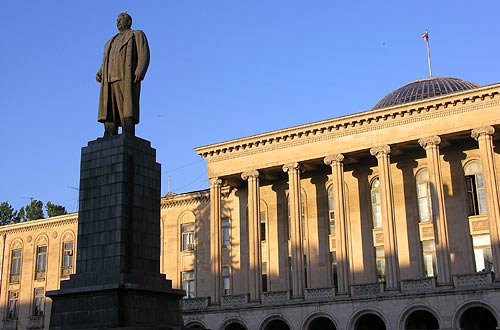
Six-meter statue of Stalin on a nine-meter pedestal was erected in his hometown of Gori in 1952. Photo: Civil.Ge.
In an unannounced move, after midnight on June 25, the authorities removed the bronze statue of Soviet dictator Joseph Stalin from the central square of his hometown of Gori.
The statue, which is planned to be moved to Stalin’s museum in Gori, will be replaced with a memorial of “victims of totalitarian regime and of the August war,” officials said.
The late night removal of the statue apparently aimed at avoiding possible protest of those local residents of Gori, who were strongly against of the statue's removal from the town's central square.
Police was sealing off the area and initially some journalists were barred from filming the statue's removal process. It was reported that a local TV station's crew was physically assaulted by the police when they tried to film the process.
Gori-based Trialeti TV posted on its Facebook page at about 2am a message reading: "Stalin monument in Gori is being removed. Police sealed off the area. Trialeti TV crew was filming when the police seized video camera and beaten journalist Lado Bitchashvili and cameraman Imeda Gogoladze."
Later Trialeti TV’s journalist said that police returned the camera and allowed the TV crew to film the removal process.
A CCTV camera from which a live video feed from Gori central square is available on livegeorgia.ge, a website generating live video streaming from various locations across Georgia, was veiled to make developments on the square not visible. When CCTV was unveiled at about 3:30am an empty nine-meter pedestal of the statue was visible in front of the Gori's local administration headquarters.
The fate of a six-meter statue, which was erected in 1952, a year before Stalin's death, was becoming a source of debates in Georgia time after time. The last time when discussions on the matter emerged was last autumn, when a group of well-organized activists launched a campaign demanding the monument's removal from the Gori central square to Stalin's museum, not far from the place where the statue was located; some were calling for destroying the statue. Those who were against of removal varied in reasoning - one part was against simply because Stalin is still a source of pride for some Georgians, mainly for an older generation. But some opponents of the idea of removal argued that tearing down the statue would not help changing mentality and the statue was part of the country's history, no matter how unpleasant it was.
The most recently, when the Stalin statue in Gori captured public attention, was in April, because of Georgian powerful interior minister Vano Merabishvili's controversial remarks. In an interview with the Russian daily, Kommersant, Merabishvili, while trying to explain that Georgia and Russia had "different values", said that after the August war a senior Georgian lawmaker offered Russian military commander, who at the time was in control of the town of Gori to blow up the Stalin statue for money.
"They [the Russian military] have bombed Gori, but they did not touch monument of Stalin," Merabishvili said. "They [Russian militaries] felt insulted [after hearing the proposal to blow up the statue]. They were ready to take money for everything else, but not for that [destruction of the Stalin statue]," Merabishvili said.
Georgian Minister of Culture, Nikoloz Rurua, said on June 25 that keeping of monument of the Soviet dictator, who was one of the masterminds of Georgia’s occupation by the Bolshevik Red Army in 1921, in the center of Gori was totally unacceptable and “misunderstanding.”
“We are announcing an international competition for the design of the monument to the victims of this person [Stalin], of totalitarian regime and of the August war… We are inviting everyone throughout the world to submit their proposals,” Rurua said and added that the new memorial would also be dedicated to a memory of Stan Storimans, a Dutch cameraman with Netherlands-based television channel RTL Nieuws, who was killed in Russian bombing of Gori during the August war.
President Saakashvili said that it was incompatible to have a museum of Soviet occupation and “at the same time a statue of the man who carried out that occupation.”
“So I fully support this decision by the local Gori municipality and the Ministry of Culture,” he said and added that at the same time it was needed to show “civilized attitude towards history” and for that reason the statue was moved to the Stalin museum.

 RSS
RSS Mobile
Mobile Twitter
Twitter Facebook
Facebook